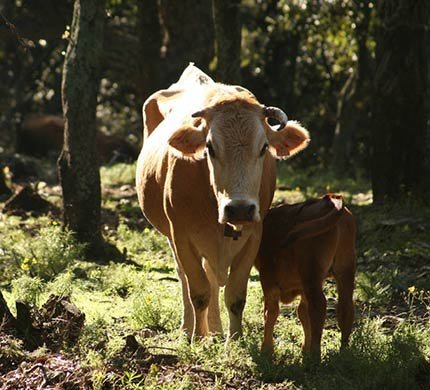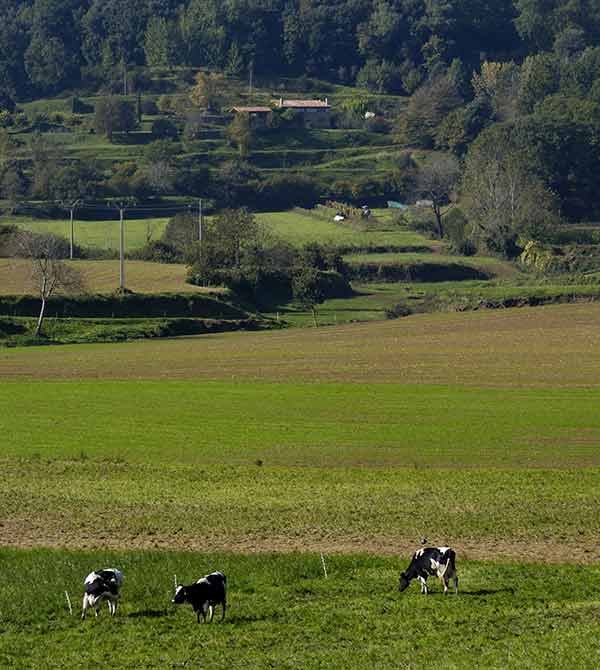Albera Cattle
- Temperature:Generally 100.4°F to 102.5°F
- Milk:3,000-4,000 pounds per lactation
- Food:Hay, silage, or other stored forages
- Pregnancy:Around 280 to 290 days
- Nationality:Northeastern Spain

General Information
Albera cattle are a breed of cattle that originated in the region of Catalonia, which is an autonomous community in northeastern Spain. The breed is named after the Albera Mountains, which is a mountain range located in the eastern Pyrenees that stretches across the border between France and Spain.
Albera cattle are medium-sized cattle that are well adapted to the rugged terrain and harsh climate of the region. They are known for their hardiness, adaptability, and ability to thrive on marginal forage resources. The breed is typically used for beef production, but they may also be used for milk production in some cases.
Albera cattle have a distinctive appearance, with a short, stocky build and a reddish-brown coat that is sometimes flecked with white. They have short, curved horns and are typically docile and easy to handle.
Where we find this cow to buy?
If you are looking to buy Albera cattle, it may be challenging to find them outside of their native region of Catalonia. However, it may be possible to locate breeders or associations that specialize in the breed and can provide more information on availability.
One place to start your search is by contacting breed associations or livestock organizations in Catalonia or Spain that are associated with Albera cattle. They may be able to provide you with a list of breeders or contacts that can help you find Albera cattle for sale.
Another option is to search online for livestock classifieds or forums that specialize in rare or heritage breeds of cattle. You may be able to find Albera cattle for sale from breeders or individuals who are looking to sell their animals.
It’s important to note that purchasing livestock from a distance can come with some risks, such as transportation and health concerns. It’s a good idea to work with a reputable breeder or seller who can provide you with information on the animal’s health history and vaccination status, and who can help arrange transportation if necessary.

How to increase milk production in Albera Cattle
While Albera cattle are primarily raised for meat production, there are some steps that can be taken to increase milk production in lactating cows. Here are some general strategies for increasing milk production in cattle:
01
Cows need a well-balanced and nutritious diet to produce milk. Feeding cows a diet that is high in energy, protein, and fiber can help to increase milk production.
02
Milking cows regularly helps to stimulate milk production and maintain udder health.
03
Provide clean, fresh water for cows to produce milk, and ensure water sources are easily accessible and free from contaminants.
04
Selecting for high milk production traits through breeding can help improve milk production in the herd over time.
Medicine
The types of medicines that are used for Albera cattle are similar to those used for other breeds of cattle. Here are some common types of medicines that may be used for Albera cattle:
01
AntibioticsAntibiotics are used to treat bacterial infections in cattle. They are typically administered under the guidance of a veterinarian and may require a prescription.
02
Parasite control medicationsParasites such as internal worms and external parasites can cause health problems in cattle.
03
VaccinesVaccines are used to prevent infectious diseases in cattle. Common vaccines for cattle include those for respiratory diseases, clostridial diseases, and reproductive diseases.
04
Pain medicationsPain medications may be used to manage pain in cattle that have undergone surgery or have other health issues that cause discomfort.
Pregnancy
Albera cows are typically bred either through natural mating or through artificial insemination (AI). Breeding is typically timed to coincide with the cow’s estrous cycle, which occurs roughly every 21 days.
The gestation period for cattle is approximately 283 days, or roughly 9 months. During this time, the cow’s body undergoes significant changes to support the developing fetus.
As the pregnancy nears its end, the cow will begin to show signs of imminent labor, such as restlessness, udder development, and a relaxed tailhead.
Monitor the cow’s health and nutrition during pregnancy to ensure she remains healthy and the calf receives adequate nutrition.
Important!
It’s important to note that proper herd management practices, such as good nutrition, health monitoring, and appropriate breeding practices, can help to ensure successful pregnancies and healthy calves.
Food
Albera cattle, like all cattle, require a balanced and nutritious diet to maintain their health and productivity. Here are some common food types for Albera cattle:
Forage, such as grass, hay, and silage, is a primary component of the diet for most cattle. Albera cattle are typically raised in grassland areas and are adapted to grazing on natural pastures. Providing access to high-quality pasture or hay can help to meet their nutritional needs.
Concentrate feeds, such as corn and other grains, can be used to supplement the diet and provide additional energy and protein. However, concentrate feeds should be used in moderation and under the guidance of a veterinarian or animal nutritionist to avoid overfeeding and digestive problems.
Cattle require a range of minerals and vitamins to maintain their health, which can be provided through supplements or vitamin-enriched feeds.
Access to clean and fresh water is essential for cattle, and providing adequate water is critical for their health and productivity.
Facts
Here are some facts about Albera cattle:
Albera cattle are a breed of cattle that originated in the Catalan Pyrenees region of northeastern Spain. They are named after the Albera Massif, a mountain range in the region.
Albera cattle are a hardy breed that are well adapted to the rugged terrain and harsh climate of their native region. They are known for their resilience, agility, and hardiness.
Albera cattle have been bred for their hardiness and resilience, making them a good choice for farmers looking for low-maintenance cattle that can thrive in challenging environments.
Albera cattle are primarily used for meat production, although they also produce milk. They are known for their high-quality beef, which is prized for its flavor and tenderness.
The breed is recognized for its distinctive appearance, which includes a long, narrow head, upward-curving horns, and a black or dark brown coat.
Albera cattle are raised using traditional grazing methods, grazing on natural pastures in the summer and being fed hay and other forages in the winter.
Efforts are underway to conserve the breed and promote its use in sustainable agriculture, with only a few thousand remaining worldwide.
The breed is medium-sized, with cows weighing between 550-700 kg and bulls weighing between 800-1000 kg.